#Automotive Bearing Market
Explore tagged Tumblr posts
Text
Automotive Bearing Market Insights: Revolutionizing Efficiency and Sustainability in Global Mobility Solutions
The automotive bearing market is a cornerstone of modern vehicle engineering, ensuring smooth operations and optimal functionality across diverse automobile components. Bearings play a crucial role in reducing friction, improving efficiency, and enhancing durability in cars, commercial vehicles, and specialty vehicles. With advancements in automotive technology, the demand for high-performance, lightweight, and energy-efficient bearings has surged. This blog delves into the key aspects of the automotive bearing market, including industry trends, growth drivers, challenges, and future opportunities.

Market Overview and Trends
The global automotive bearing market is experiencing significant growth, driven by rising vehicle production, technological innovations, and stringent fuel efficiency regulations. The introduction of electric and hybrid vehicles has further reshaped the industry, as these vehicles demand specialized bearings tailored for electric motors and regenerative braking systems. Key trends include the use of advanced materials such as ceramics and composites, integration of smart sensors into bearings, and a shift towards more eco-friendly lubricants.
Moreover, Industry 4.0 and IoT-enabled technologies have contributed to the rise of smart bearings. These advanced products offer real-time data on parameters like temperature, load, and lubrication, enhancing operational efficiency and predictive maintenance capabilities. Manufacturers are focusing on reducing the overall carbon footprint, which aligns with global sustainability objectives.
Key Growth Drivers
Increasing Vehicle Production: As global economies recover post-pandemic, the demand for personal and commercial vehicles is rising, fueling the need for automotive bearings.
Electrification of Vehicles: The transition to electric and hybrid vehicles requires innovative bearing designs to cater to unique operational demands.
Technological Innovations: Advancements in material science and manufacturing processes have resulted in lightweight, durable bearings with enhanced performance.
Stringent Emission Norms: Regulatory mandates worldwide have driven manufacturers to adopt energy-efficient components, boosting the adoption of advanced bearings.
Aftermarket Expansion: The growing vehicle fleet has accelerated demand in the aftermarket segment, further driving revenue growth.
Challenges and Constraints
While the market offers promising growth opportunities, certain challenges persist. Fluctuations in raw material prices can impact profitability, while complex supply chain dynamics post-pandemic pose additional concerns. Furthermore, the transition to electric vehicles requires a reorientation of traditional bearing design and manufacturing processes, demanding significant investment in research and development.
Regional Dynamics
Asia-Pacific: Dominates the automotive bearing market due to its large vehicle production capacity, especially in China, India, and Japan.
North America: Driven by high adoption rates of advanced technologies and robust electric vehicle markets.
Europe: Focused on sustainability and emission reduction, with key contributions from Germany and the Nordic countries.
Rest of the World: Emerging markets in South America and Africa are showing steady growth, driven by increasing automotive investments.
Future Opportunities
The automotive bearing market is set to benefit from collaborations and partnerships among OEMs, suppliers, and technology providers. The rise of autonomous vehicles and advanced driver assistance systems (ADAS) presents opportunities for innovative bearing solutions with high precision and reliability. Furthermore, investments in green technologies and renewable energy sources will continue to shape the future of the industry.
0 notes
Text
Automotive Bearing Market To Witness the Highest Growth Globally in Coming Years
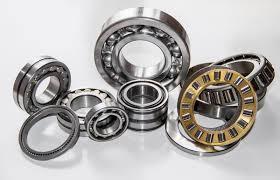
The report begins with an overview of the Automotive Bearing Market and presents throughout its development. It provides a comprehensive analysis of all regional and key player segments providing closer insights into current market conditions and future market opportunities, along with drivers, trend segments, consumer behavior, price factors, and market performance and estimates. Forecast market information, SWOT analysis, Automotive Bearing Market scenario, and feasibility study are the important aspects analyzed in this report.
The Automotive Bearing Market is experiencing robust growth driven by the expanding globally. The Automotive Bearing Market is poised for substantial growth as manufacturers across various industries embrace automation to enhance productivity, quality, and agility in their production processes. Automotive Bearing Market leverage robotics, machine vision, and advanced control technologies to streamline assembly tasks, reduce labor costs, and minimize errors. With increasing demand for customized products, shorter product lifecycles, and labor shortages, there is a growing need for flexible and scalable automation solutions. As technology advances and automation becomes more accessible, the adoption of automated assembly systems is expected to accelerate, driving market growth and innovation in manufacturing.
The global automotive bearing market size was valued at USD 14.35 billion in 2022. The market is projected to grow from USD 14.76 billion in 2023 to USD 19.46 billion by 2030, exhibiting a CAGR of 4.0% during the forecast period.
Get Sample PDF Report: https://www.fortunebusinessinsights.com/enquiry/request-sample-pdf/102229
Key Strategies
Key strategies in the Automotive Bearing Market revolve around optimizing production efficiency, quality, and flexibility. Integration of advanced robotics and machine vision technologies streamlines assembly processes, reducing cycle times and error rates. Customization options cater to diverse product requirements and manufacturing environments, ensuring solution scalability and adaptability. Collaboration with industry partners and automation experts fosters innovation and addresses evolving customer needs and market trends. Moreover, investment in employee training and skill development facilitates seamless integration and operation of Automotive Bearing Market. By prioritizing these strategies, manufacturers can enhance competitiveness, accelerate time-to-market, and drive sustainable growth in the Automotive Bearing Market.
Major Automotive Bearing Market Manufacturers covered in the market report include:
JTEKT Corporation (Japan)
SKF (Sweden)
Schaeffler AG (Germany)
NSK Ltd (Japan)
NTN Corporation (Japan)
TIMKEN (U.S.)
Nippon Thompson (Japan)
RBC Incorporation (U.S.)
Iljin Co., Ltd. (South Korea)
CW Bearing (Germany)
favourable trends associated with the transportation of goods will drive the commercial vehicle demand. As mentioned earlier, these trends will drive the automotive bearing market growth during the forecast period.
Trends Analysis
The Automotive Bearing Market is experiencing rapid expansion fueled by the manufacturing industry's pursuit of efficiency and productivity gains. Key trends include the adoption of collaborative robotics and advanced automation technologies to streamline assembly processes and reduce labor costs. With the rise of Industry 4.0 initiatives, manufacturers are investing in flexible and scalable Automotive Bearing Market capable of handling diverse product portfolios. Moreover, advancements in machine vision and AI-driven quality control are enhancing production throughput and ensuring product consistency. The emphasis on sustainability and lean manufacturing principles is driving innovation in energy-efficient and eco-friendly Automotive Bearing Market Solutions.
Regions Included in this Automotive Bearing Market Report are as follows:
North America [U.S., Canada, Mexico]
Europe [Germany, UK, France, Italy, Rest of Europe]
Asia-Pacific [China, India, Japan, South Korea, Southeast Asia, Australia, Rest of Asia Pacific]
South America [Brazil, Argentina, Rest of Latin America]
Middle East & Africa [GCC, North Africa, South Africa, Rest of the Middle East and Africa]
Significant Features that are under offering and key highlights of the reports:
- Detailed overview of the Automotive Bearing Market.
- Changing the Automotive Bearing Market dynamics of the industry.
- In-depth market segmentation by Type, Application, etc.
- Historical, current, and projected Automotive Bearing Market size in terms of volume and value.
- Recent industry trends and developments.
- Competitive landscape of the Automotive Bearing Market.
- Strategies of key players and product offerings.
- Potential and niche segments/regions exhibiting promising growth.
Frequently Asked Questions (FAQs):
► What is the current market scenario?
► What was the historical demand scenario, and forecast outlook from 2024 to 2030?
► What are the key market dynamics influencing growth in the Global Automotive Bearing Market?
► Who are the prominent players in the Global Automotive Bearing Market?
► What is the consumer perspective in the Global Automotive Bearing Market?
► What are the key demand-side and supply-side trends in the Global Automotive Bearing Market?
► What are the largest and the fastest-growing geographies?
► Which segment dominated and which segment is expected to grow fastest?
► What was the COVID-19 impact on the Global Automotive Bearing Market?
Table Of Contents:
1 Market Overview
1.1 Automotive Bearing Market Introduction
1.2 Market Analysis by Type
1.3 Market Analysis by Applications
1.4 Market Analysis by Regions
1.4.1 North America (United States, Canada and Mexico)
1.4.1.1 United States Market States and Outlook
1.4.1.2 Canada Market States and Outlook
1.4.1.3 Mexico Market States and Outlook
1.4.2 Europe (Germany, France, UK, Russia and Italy)
1.4.2.1 Germany Market States and Outlook
1.4.2.2 France Market States and Outlook
1.4.2.3 UK Market States and Outlook
1.4.2.4 Russia Market States and Outlook
1.4.2.5 Italy Market States and Outlook
1.4.3 Asia-Pacific (China, Japan, Korea, India and Southeast Asia)
1.4.3.1 China Market States and Outlook
1.4.3.2 Japan Market States and Outlook
1.4.3.3 Korea Market States and Outlook
1.4.3.4 India Market States and Outlook
1.4.3.5 Southeast Asia Market States and Outlook
1.4.4 South America, Middle East and Africa
1.4.4.1 Brazil Market States and Outlook
1.4.4.2 Egypt Market States and Outlook
1.4.4.3 Saudi Arabia Market States and Outlook
1.4.4.4 South Africa Market States and Outlook
1.5 Market Dynamics
1.5.1 Market Opportunities
1.5.2 Market Risk
1.5.3 Market Driving Force
2 Manufacturers Profiles
Continued…
About Us:
Fortune Business Insights™ delivers accurate data and innovative corporate analysis, helping organizations of all sizes make appropriate decisions. We tailor novel solutions for our clients, assisting them to address various challenges distinct to their businesses. Our aim is to empower them with holistic market intelligence, providing a granular overview of the market they are operating in.
Contact Us:
Fortune Business Insights™ Pvt. Ltd.
308, Supreme Headquarters,
Survey No. 36, Baner,
Pune-Bangalore Highway,
Pune - 411045, Maharashtra, India.
Phone:
US:+1 424 253 0390
UK: +44 2071 939123
APAC: +91 744 740 1245
#Automotive Bearing Market#Automotive Bearing Market Share#Automotive Bearing Market Size#Automotive Bearing Market Trends
0 notes
Text
Increasing Demand for Vehicles in Emerging Economies Driving Demand for Automotive Bearings
The affordability of vehicles has increased significantly over the past few years. Technological advancements have paved the way for cheaper vehicles, along with which, the increasing disposable income of people has made it easier for them to buy private vehicles. Owing to these factors, the global automotive industry has been registering considerable growth over the past few years. Developing countries, including China, Indonesia, India, and Thailand are majorly contributing to the growth of the automotive industry.
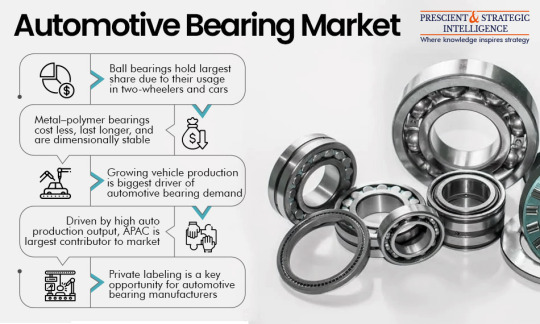
Bearings are majorly of three types, namely plain bearing, roller bearing, and ball bearing, among which, the demand for ball bearings has been the highest up till now. These bearings are utilized widely in two-wheelers and passenger cars. Ball bearings are further of different types, namely self-aligning, deep-grove ball bearing, angular contact ball bearing, and thrust ball bearing. In the coming years, however, the demand for roller bearings is projected to grow significantly.
This is due to the increasing sales of heavy-duty vehicles. In addition to this, the latest enhancements in heat generation and reducing friction by these bearings is also predicted to create their high demand for off-road vehicles and commercial vehicles. Thrust roller bearing, needle roller bearing, spherical roller bearing, cylindrical roller bearing, and tapered roller bearing are the different types of roller bearings. Among all these, the demand for tapered roller bearings is expected to be significantly high in the years to come.
Bearings are made of different kinds of materials, such as fiber-reinforced composite, solid polymer, and metal polymer. Out of these, the demand for metal polymer bearings has been the highest in the past, owing to the various advantages of this material, including long-lasting nature, cost-effectiveness, dimensional stability, and negligible stick-slip. Among the different vehicle types, the demand for automotive bearings is predicted to rise significantly for electric vehicles in the years to come.
The increasing acceptance of electric vehicles and government policies for encouraging their adoption are projected to drive the demand for automotive bearings in the years to come. The Asia-Pacific region emerged as the major automotive bearing market in the past and the situation is likely to remain the same in the years to come as well. The regional domain is being led by China, as the demand for automobiles in the country is on a rise. In addition to this, the exports of small-sized and low-end sized bearings are leading to the expansion of the domain in the country.
In conclusion, the market is growing due to the rapid expansion of the automotive industry in developing countries.
#Automotive Bearing Market Share#Automotive Bearing Market Size#Automotive Bearing Market Growth#Automotive Bearing Market Applications#Automotive Bearing Market Trends
1 note
·
View note
Text
The Van Has Officially Declared It Spooky Season
---
I've got my parent's van for the week and it seems determined to establish my status as The Local Cryptid by terrorizing an innocent 7-11 clerk.
...I might need to back up a bit.
My mother is an eminently sensible woman who knows herself well, and when The Plauge hit, she knew she'd need some sort of mentally and physically engaging craft project to keep herself from going insane and massacring the local zoning and water management boards (even if they have it coming). So she and Dad acquired a utility van and converted it into a camper van because while they love camping, they're past the age where their joints and immune systems will tolerate sleeping on the cold ground in a nylon tent.
They did a terrific job of it and my mom taught herself woodworking and carpentry and now the van has it's own cabinets, fold-away dining table, and removable queen-sized bed with memory foam mattress. My Dad was already a computer engineer, but he learned the dark magics of automotive software and electronics to install after-market backup cameras, a media player that would take a terabyte hard drive and a solar-powered battery and outlet so they could wake up and just turn on the kettle and griddle for breakfast without having to exit the van into a cold morning on an empty stomach.
Truly, the height of Camping Luxury.
My parents are both in their mid-seventies and my primary life goal is to be at least half as cool and hale as they are when I get old.
Anyway, they take it out at least a dozen times a year and it works fabulously, but, being as I am on good terms with my parents and also finishing the process of moving house, I've been borrowing it to move large and cumbersome objects that will not fit in the back of my equally lovely but minuscule Honda hatchback.
It's a Great Van. Very easy and comfortable to drive. Stunningly good MPG for it's size. The best cruise control I've ever had in a car.
It's just also. Quirky. Mischievous, even.
---
If this van has a fault its that it bears the unfortunate affliction that all lightly used white utility vans have in that the combination of an utter lack of branding features and the large dent/scrape I accidentally put on it while trying to escape a Denny's last Thanksgiving means that this vehicle is one addition of a Badly Spray-Painted "FREE CANDY" on the side away from being the sort of vehicle you see in an edgy horror movie.
It's got the same issue that Doberman Dogs have where they look like the sort of creature that likes to snack on toddler's faces whilst actually having personalities made of marshmallow fluff. This vehicle is unnecessarily menacing and I think nothing short of an airbrushed Epic Van Wizard will correct this. People see this van pull up and lean over and squint suspiciously at me when the driver's side door opens, and then look moderately confused when, instead of Charles Manson, a small, potato-shaped creature with neon purple hair and a statistically unlikely assortment of dogs emerges.
My own two dogs, Herschel the Hanukkah Goblin/Corgi and Charleston Chew The Taco Dumpster Dog, Do Not Like The Van. Even with the bed in it, they have a tendency to slide and roll around in the back, and both WILL chew through dog saftey belts or other attempts to secure them in there.
On the other hand, my house mate's dog, an exceptionally tall standard poodle whom we lovingly call "The Creature", loves the Van because SHE wears her doggy seat-belt with only mild complaining and gets to sit up in the passenger seat like A People.
Also like A People, The Creature likes to stand and walk around on her hind legs. It doesn't hurt her and it's entirely voluntary, but every so often I will feel a hand on my arm and instead of my husband or friend, it's a canine that's taller than I am on her hind legs who wants to stare at my face with soulful, concerned eyes. The Creature's favorite thing is that she is exactly the right height for me to hold her arm in Genteel Fashion and walk around the pet food or hardware store with her like I'm a count escorting a debutante around a royal ball.
---
As it stands, I am set to inherit this vehicle whenever my Honda gives up the ghost, and I fully intend to paint an Epic Van Wizard on it when that time comes.
The other peculiarity of The Van is that while Dad did manage to successfully install all his after-market electronics, not all the electronics get along. Sometimes, they fight for Dominance. The Terabyte Music Player and the Backup Camera have a particularly contentious relationship, and turning on the music has about a 25% chance of turning on the backup camera as well, and turning on the Backup Camera is equally likely to turn on the music.
Firthermore, The Van has a favorite song.
I am not kidding that Dad filled an entire terabyte hard drive with music and the software to sort it via the radio controls, but of all the Early Boomer Dad Rock (Kingston Trio over The Eagles) and Irish Folk and Symphonies and the entire discography of Weird Al Yankovic, The Van's favorite song- The one it picks to play as victory music every time it beats the Backup Camera at their weird electronic game of rock-paper-scissors -is The Liberty Bell March by John Phillip Sousa.
You all know this song already.
...but in case you've forgotten the tune:
youtube
Yeah.
The Van's favorite song is the goddamn Monty Python's Flying Circus Theme Music.
It does not play this song at a normal volume.
Every time I turn on the Backup Camera and it manages to turn the music player on as well, The Van insists on absolutely blasting this nonsense on at the maximum volume it's physically capable of producing, which I know is loud enough to be heard from the Denver International Airport's Pickup zone when they Van decided to start playing it from the economy lot about half a mile away.
Perhaps it's The Van's way of honoring the aesthetic sensibilities and sonic enthusiasm of Mr. Sousa.
...I can't help but wonder if the purpose of an Epic Van Wizard is to control this sort of faerie-like malarkey, and channel these chaotic energies into things like Spell of Don't Break Down In Nevada or Enchantment Of Always Have Good Parking.
---
So last Friday the 13th, I get a call from my friend and housemate, at said airport.
It's roughly 11PM at night, and I have already retired for the evening. I am in the exact minimum of clothing required to be a decent housemate and not scandalize the neighbors should I happen to walk by a window. My feet are up. There is a cat in my lap and fictional British people murdering each other in highly inventive fashion on the tv. -But my friend has returned from her friend's wedding,and either American or United Airlines has managed to lose her luggage, including, among other valuable possessions, the keys to her car. ...So she cannot just drive home as originally planned.
There are, as luck would have it, her spare set of keys not eight feet from me.
Being a good and decent person, I agree to bring the spare keys to her so she may get home before daybreak and not spend a semester's worth of tuition on an uber across the greater Denver traffic jam.
Being also that she Loves Activities, and it's her mom we're going to pick up, I elect to take along The Creature.
I am primarily focused on remembering how to get to the airport and not leaving my friend's spare keys on the counter, so I throw on a pair of flip-flops, step outside, remember that it's AUTUMN and my minimal evening attire is not sufficient thermal protection, step back in, grab the first coat in the closet I lay hands on, pull it on, check that I have her keys again and leave.
The trip to the airport is largely unremarkable, save that it becomes necessary for me to put on sunglasses to drive, despite it being nearly the witching hour and almost entirely darker than the inside of a cow.
It's necessary because this blissful darkness of night is violently punctured by a startling number of cars that seem to have installed miniaturized but no less powerful lighthouse bulbs in where their headlights ought to go so the oncoming traffic and sports cars that insist on tailgating me in the slow lane alike illuminate the road and my mirrors with the kind of radiance I'd normally associate with the arrival of a Seraphim.
I arrive at the distant highly discounted airport car lot where my housemate is waiting, deeply apologetic. It's nothing. I say. Once I see that your car starts up, I'm gonna go to that 7-11 across the way that I parked in front of, get a slurpee or something and I'll see you at home.
While she is retrieving her vehicle (an equally eccentric but much more stately Subaru that is old enough to be elected to congress) I rifle through the loose change in the glove box and discover that I have exactly $6.66 in small bills and coins. The Subaru, continuing it's long voyage into vehicular immortality, immediately starts up.
Upon her return, we all remember that my friend had all her camping gear in the backseat of the car and there is no room for The Creature to ride home with her parent, so I again assure her it's nothing, and will just take The Creature into the 7-11 with me. She is trained as a service animal and needs the practice after the plague.
I wave my friend off and turn to enter the 7-11.
I promptly trip over the jutting back bumper of The Van and fall, cartoonishly, face-first onto the sidewalk.
Fortunately, I have a lot of practice falling on my face, and have learned not to throw my hands out but instead cover my face, so my unexpected self-inflicted attempted curb-stomping lightly scrapes my hairline and nothing else -my sunglasses even stay in place- and I get up and resume my quest for a slurpee.
It's well known that the airport is a lawless place, and the 7-11 across from the discounted airport parking at the stroke of midnight is no exception.
I know it's the stroke of Midnight because there's one of those Audubon society bird-call clocks that makes bird noises, and my arrival is heralded by the twittering call of a Summer Tanager. I am almost charmed enough by the unusual choice of chronological device to excuse the exorbitant Airport-adjacent mark-up of Slurpee prices. I stand at the machine for some time, trying to decide on a size for the price and guess what the fuck "Blue Lighting Blast" is supposed to taste like.
The Creature is being Very Polite but is somewhat agitated, I assume because she *just* saw her mother for the first time in three days and then she LEFT with no explanation, so The Creature is on her hind legs, staring woefully into my eyes, asking to be escorted around the 7-11. Even though that's not what she's not supposed to be doing, there's nobody else in here, so I let her hang off my arm and discuss various Slurpee Flavor options with her.
We eventually decide on an experiment in which I try a Small Blue Lightning Blast, and discover it tastes a bit like licking a nintendo cartridge but in a pleasantly satisfying way.
I go up to pay and realize something is amiss.
The Cashier is a young man staring at me with wide eyes, one had over the register and the other wrapped up in his rosary.
I look down at myself.
In my haste to reunite my friend with her spare keys and service animal, I had left the house in the following accoutrements:
Flip Flops. Not matching. It's below freezing outside. That last part is not particularly odd footwear for the weather in for Colorado, but it's an important detail for the rest of the ensemble.
Assorted scrapes, bruises, cuts and welts on my arms and legs that come with doing outdoor work and living in a house with three dogs and a fully-clawed cat that all want to be in my lap all the time. It's cold out, so vasoconstriction has pulled the blood away from my skin, a trait that served my ancestors well during the last Ice Age, but leaves me with pale skin to contrast the various wounds and I look like a corpse that fell out of the back of a pickup truck.
The black Bootyshorts with "CRYPTID" painted in bright red gothic font across my ass, that @theshitpostcalligrapher gave me for my wedding present.
A peculiar but extremely comfortable garment that straddles the line between "Lacy Camisole" and "Industrial-Strength Sports Bra" like the Ever Given straddling the Suez Canal. It is also Bright Red. with black accents.
The Jacket I had grabbed out of the closet, which is in fact, a black Velour Dinner Jacket.
The Tokyo-Ghoul inspired reusable anti-covid mask a friend made me with the set of Coyote Teeth.
My sunglasses, which are shaped like a Halloween Bat. The lenses are the wings and the body is the nose bridge. It is ALSO bright red.
A Very Large and remarkably Humanoid Poodle that I have been audibly affectionately calling "Dear Creature" who is hanging off my arm like she's my Prom Date.
The Very Large and remarkably Humanoid Poodle is ALSO dressed up in a black Dog Sweater that has white bones printed on it to look like its an X-ray jacket showing off her skeleton.
I look like I am taking my Very Fancy Werewolf Girlfriend to a particularly casual Dinner Party for Vampires, but the thing that's really selling it and probably alarming the kid the most is the fun accessory I acquired in the parking lot not five minutes earlier:
The "Small Scrape At my Hairline" is actually a painless but PROFUSELY bleeding head wound that I had somehow entirely failed to notice covering my face, neck, decolletage and magnificent cleavage with blood like a Tarantino Film Extra.
This does explain why The Creature has been delicately trying to use her bodyweight to push me down onto the floor for the last ten minutes. So I don't injure myself while we wait for the paramedics she hoped this kid called to arrive, you see.
The Creature has such a High and Naive Opinion of humanity.
I decide this social situation is already fucked, and the only way out is through, and with haste, before I start dripping on the floor.
"Hi there!" I say cheerfully, to indicate this is a visually alarming but not terribly serious situation. "Just a Small Slurpee!"
The Cashier has entered the relevant code into the register before I finish the sentence. His gaze flicks off me just long enough to look at the total, and he grips his Rosary harder.
$6.66
"Oh cool! I have exact change!" I say, taking the money out of my as-yet-unsanguined pocket without looking and slap it down on the counter. "You have a good night and be safe out there!" I wave, leaving.
I get in The Van, mortified, buckle The Creature up, and as I make to leave, I have to put it in reverse, which automatically turns on the backup Camera.
It also turns on the music player.
I make eye contact with the cashier as the dulcet tones of John Phillip Sousa boom from the van hard enough to make the windshield and the windows of the 7-11 rattle for the nine-and-a-half seconds I have to wait to be able to turn the volume back down. Not knowing what else to to, I give him a thumbs up, and leave.
Anyway, now I know what my Future Van Wizard has got to be dressed like, and what their familiar is.
---
If you enjoyed this story, please consider donating to my Ko-Fi or Pre-ordering my Family Lore Funny Stories book on Patreon
#Family Lore#Dogs#It's Halloween babey#friday the 13th#blood mention#I hope that kid had a good night and at least one of his friends believed him#Long post#Video
16K notes
·
View notes
Text
Automotive Bearings Market Set for Rapid Growth During 2020 – 2030
“Market Research on Automotive Bearings Market – Growth Rate, Market Share & Size” is the name research released by The Insight Partners and is now out for purchase. The business focuses on consulting and specializes in syndicated market research. The company is assisting Automotive Bearings market investors by providing both qualitative and quantitative data through this study. Business…

View On WordPress
0 notes
Text
Automotive Engine Bearings Market -industry Insights By Growth, Emerging Trends And Forecast By 2027
Recent report titled published by research nester “Automotive Engine Bearings Market: Global Historical Growth (2012-2016) & Future Outlook (2017-2027) Demand Analysis & Opportunity Evaluation” delivers detailed overview of the global automotive Engine Bearings market in terms of market segmentation by type, by vehicle type, by sales channel and by region.
Further, for the in-depth analysis, the report encompasses the industry growth drivers, restraints, supply and demand risk, market attractiveness, BPS analysis and Porter’s five force model.
he global automotive engine bearings market is segmented into sales channel such as OEM and aftermarket. Among these segments, OEM engine bearings segment is expected to occupy top position in overall automotive engine bearings market during the forecast period. This can be attributed to healthy automotive production trend. Moreover, automotive production is believed to increase in the upcoming years on the account of growing urbanization and increasing disposable income of the population. This factor is anticipated to intensify the growth of the automotive engine bearings market in the years ahead.
Request Sample To Learn More About This Report @ https://www.researchnester.com/sample-request-803
Global automotive engine bearings market is expected to flourish at a significant CAGR of 5.7% during the forecast period. The market stands to benefit from increasing automotive production and replacement in aftermarket. Moreover, the global Automotive Engine Bearings Market is expected to garner USD 211.8 Billion by the end of 2027.
Asia Pacific captured the largest market share in overall automotive engine bearings market and is expected to continue its dominance over the forecast period. Highest automotive production is the primary reason behind the Asia Pacific lion’s market share. Further, growing purchasing power of the people in developing nations is anticipated to foster the growth of automotive market in the upcoming years. Europe automotive engine bearings market is anticipated to showcase significant growth during the forecast period. Moreover, Latin America is anticipated to grow at modest CAGR during the forecast period. Further, positive GDP growth coupled with growing automotive market in the region is anticipated to drive the growth of the automotive engine bearings in Latin America.
Healthy Automotive Production
Increasing automotive production is the major growth driver of global automotive engine bearings market. According to OICA, total motor vehicle production was held to be 97,302,534 units in 2017. This represented a growth of 2.4% in 2017 as compared to 2016. Further, automotive production is expected to increase on the account of rising demand. This factor is envisioned to bolster the growth of automotive engine market.
Automotive Aftermarket Industry Reflects Significant Opportunities
Growth in automotive vehicle size on the road is creating significant aftermarket opportunities for automotive engine bearings market. As engine bearing falls in wear and tear replacement category of automotive part, demand for replacement automotive engine bearings is likely to uplift during the forecast period on the account of growing number of aging vehicles.
Although, volatility in raw material price is likely to dampen the growth of automotive engine bearings market during the forecast period.
This report also provides the existing competitive scenario of some of the key players of the global automotive engine bearings market which includes company profiling:
MAHLE Aftermarket Inc., Schaeffler AG, SNL Bearings Ltd., ORS Bearings, Nachi Fujikoshi Corp., RBC Bearings, NSK Ltd. King Engine Bearings, Inc., Timken Company, Svenska Kullagerfabriken AB and NTN Corporation.
The profiling enfolds key information of the companies which encompasses business overview, products and services, key financials and recent news and developments. On the whole, the report depicts detailed overview of the global automotive engine bearings market that will help industry consultants, equipment manufacturers, existing players searching for expansion opportunities, new players searching possibilities and other stakeholders to align their market centric strategies according to the ongoing and expected trends in the future .Get Exclusive Sample Report Copy Of This Report @ https://www.researchnester.com/sample-request-803
0 notes
Text
Latest Automotive Ball and Roller Bearings market research report examines the potential growth opportunities and trends and forecasts for the period from 2023 to 2030.
0 notes
Text
Global Bearings Market is forecasted to grow further into US$ 120 billion Opportunity by 2028: Ken Research
Buy Now
What is the Size of Global BEARING INDUSTRY?
Global Bearing market is growing at a CAGR of ~% in 2017-2022P and is expected to reach ~USD Bn by 2028F.
The Bearing Market is largely driven by continuous upgradation in the product from multiple players, and growing usage of bearings.
New product launches by players and collaboration among the industry is one of the driving factors of the Global Bearing Market. For instance, In June 2022, The Timken Company announced that it is designing and supplying main shaft bearings for GE Renewable Energy Haliade-X, the world’s most powerful offshore wind turbine. Furthermore, In December 2020, The Timken Company acquired the assets of Aurora Bearing Company.
Aurora manufactures rod ends and spherical plain bearings, which serve a diverse range of defense sector.
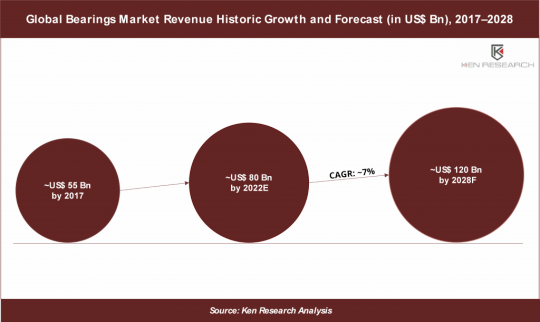
Interested to Know More about this Report, Request for a sample report
Counterfeit products are posing one of the major challenges for the Bearings Market. Leading companies in bearings product manufacturing are more open to this threat. Manufacturing fake products lead to machine damage and injuries. For instance, In October 2019, JTEKT cooperated with World Bearing Association (WBA) and its efforts against counterfeiting globally by developing a new WBA Check App (WBA Bearing Authenticator) to protect its customers and dealers from property damage risk, injuries, and other events.
GLOBAL BEARING MARKET BY PRODUCT TYPE
The Global Bearing market is segmented by Product type into Plain Bearing, Ball Bearing, Roller Bearing and Others.
Rolling bearing segment held the largest market share of the Global Bearings Market in 2022P. Rolling bearings are used in multiple industries such as automotive, capital equipment, aerospace, home appliances, and others
Roller bearing is a type of rolling-element bearing that used a cylinder instead of a ball. Roller bearings are used in all main shaft and auxiliary drive shaft applications to support the pure radical load.
In July 2021, NTN Bearing Corporation announced the latest innovation, the KIZEI spherical roller bearing. Spherical roller bearings are manufactured with metallic shields that protect the bearing from solid contamination such as dust, pebbles, and other debris.
GLOBAL BEARING MARKET BY APPLICATION TYPE
The Global Bearing Market is segmented by Application into Automotive, Application Transmission, Aerospace & Defense, Construction and Others.
The automotive segment accounted for the largest market share in 2022P, owing to the surging automobile production worldwide.
Visit this Link :- Request for custom report
The increasing demand for vehicles is leading the automotive segment and is forecasted to be the fastest-growing segment in the forecast period.
In September 2022, SKF and NIO, a leading premium smart electric vehicle manufacturer, have strengthen the strategic corporation. As part of the agreement, SKF will be the preferred supplier of ceramic ball bearings.
GLOBAL BEARING MARKET BY GEOGRAPHY
The Global Bearing market is segmented by geography into North America, Europe, Asia- pacific and LAMEA.
Asia Pacific accounted for the largest market share within the Global Bearings Market in 2022P, owing to surging machinery and motor vehicle production.
The increasing demand for aftermarket products for industrial equipment and motor vehicle repair. The surging construction and mining industry requires efficient industrial tools to operate, which further propels the growth of this region. Presence of leading companies manufacturing bearings products, like JTEKT Corporation, NSK Ltd., NTN Corporation, HKT Bearings Ltd., and others, are expected to further boost the expansion of this market.
For More Insights On Market Intelligence, Refer to the Link Below: –
Global Bearings Market
#Africa Bearings Market Forecast#Asia Pacific Bearings Market#Automotive Bearings Supplying Companies#Ball Bearings Market#Bearings Material Suppliers Globally#Bearings Products Market#Bearings Raw Material Suppliers#Challenges in Growth of Bearings Market#Competitors in Bearings Market#Demand for Bearing in Consumer Sector#Distributors of Bearings Globally#Emerging Companies in Bearing Market#Europe Bearings Market Forecast#Global Ball Bearing Market#Global Ball Screw Market#Global Bearing Distributors#Global Bearings Industry#Global Bearings Industry Outlook#Global Bearings Market#Global Bearings Market Trends#Global Flexure Bearings Market#Global Magnetic Bearings Market#HKT Linear Bearings Market#India Bearings Market#Investment in Bearing Manufacturing Start-ups#JTEKT Deep Groove Ball Bearings Market#Latin America Bearings Market Forecast#Leading Players in Bearing Market#Major Players in Bearings Market#Middle East Bearings Market Revenue
0 notes
Link
According to our new research study on "Global Bearing Steel Market Size Report, Forecast to 2028 – COVID-19 Impact and Global Analysis – by Type, End User, and Geography,"
0 notes
Text

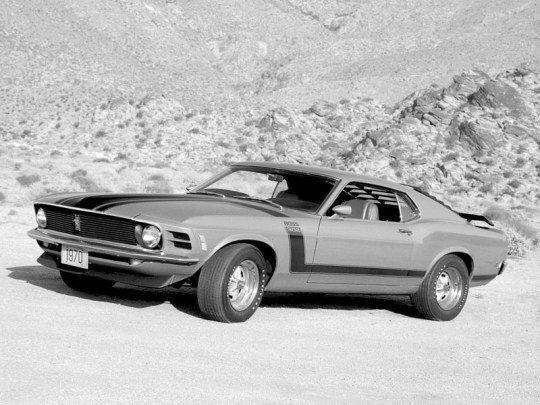
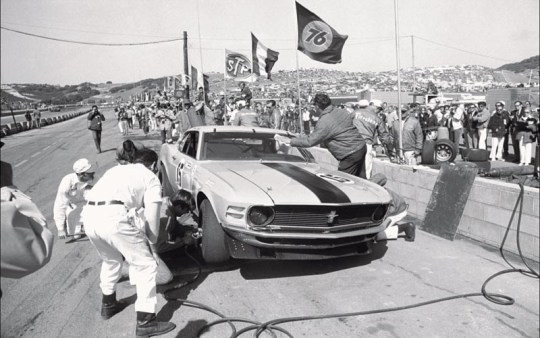
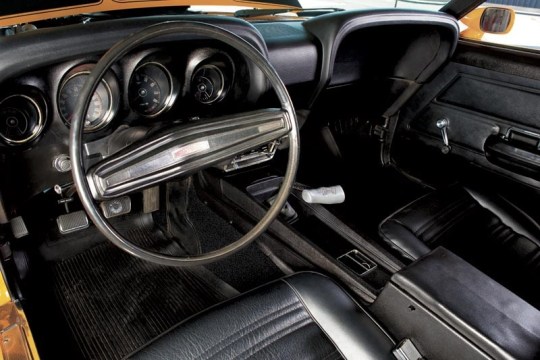
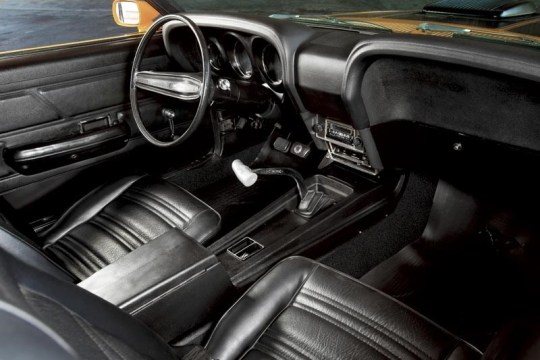
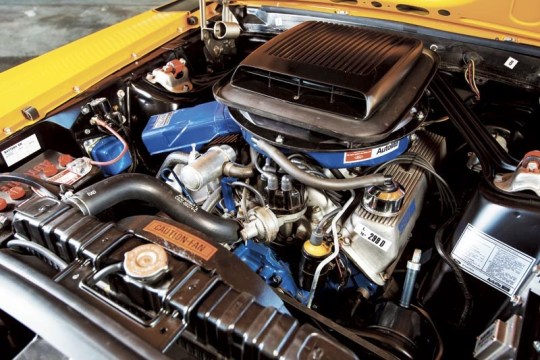


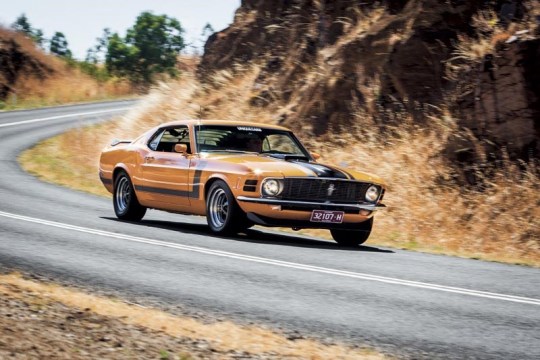

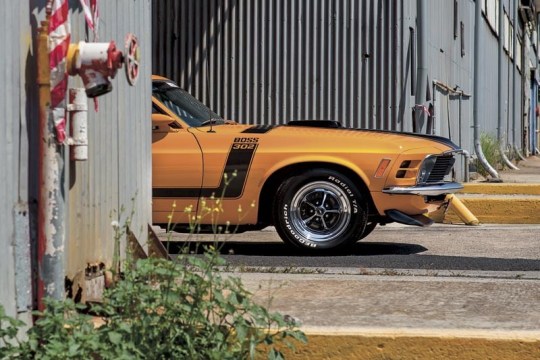
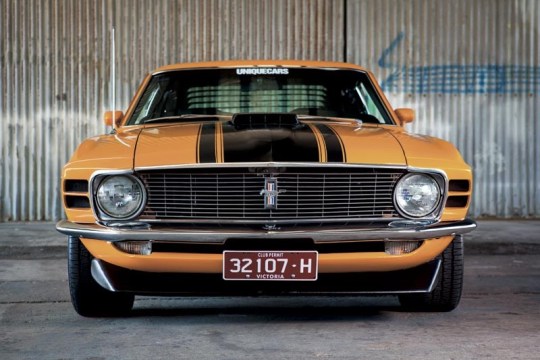
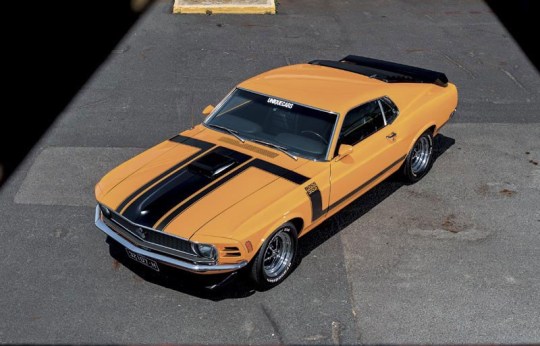
FORD MUSTANG BOSS 302
BOSS-A-NOVA!
They called it The Boss and for two short years it ruled the muscle car scene in the US, establishing itself as one of the greatest road and race cars of the era. Now, it’s one of the most collectible.
In 1960s US street lingo, if something was ‘boss’ it was cool, tough, the best. And the 1969 Boss 302 Mustang wore its badge with pride. It launched just four and a half years after the first Mustang was revealed to critical acclaim and record sales. Yearly updates to keep Mustang fresh in the face of tough new challengers from General Motors and Chrysler (particularly the Camaro) resulted in the once lean and pretty ’Stang muscling up, both in body shape and under-bonnet brawn, and the 1969-70 Boss models were the zenith of Mustang styling.
Thereafter, Mustangs became increasingly bloated and anaemic as the 1970s fuel crisis and stricter pollution laws cut horsepower and stylists lost their way; the rippling flanks and thrusting nose of the late 60s/early 70s cars gave way to boxy, bland designs. That early look would not be recaptured until 2005, when new Mustangs were given retro styling.
The Boss 302 was launched at the same time as its big-block brother, the Boss 429. Both were positioned as competition specials; Ford wanted to homologate its 302-cuber for Trans-Am and the 429ci monster for NASCAR. In fact, Ford went wild with engines between 1969-70, offering nine V8s – the ‘economy’ 302, 351 Windsor, 351 Cleveland, 390, 428 Cobra Jet, 428 Super Cobra Jet, 429 ‘wedge’, Boss 302 and Boss 429.
For the Boss 302, Ford’s high-compression 302ci small-block V8 was beefed up with four-bolt main bearing caps and redesigned ‘Cleveland’ cylinder heads with bigger inlet and exhaust valves, and ports that allowed the engine to breathe more efficiently.
These ‘semi-hemi’ heads were based on the Ford 427ci racing engine’s combustion chambers, and a balanced forged steel crankshaft and forged steel conrods allowed the engine to handle high rpms for sustained periods. A single 780cfm four-barrel Holley carburettor sat atop a high-rise aluminium inlet manifold, while a dual-point distributor, high-pressure oil pump, windage tray and screw-in welch plugs were further indications of its competition intent.
A rev limiter was fitted, progressively cutting spark from 5800rpm to 6150, but it was easily bypassed and the Boss 302 could reportedly keep making power up to 8000rpm with minor mods. In the muscle car marketing war, Ford claimed a peak horsepower figure of 290bhp at 5800rpm (the same as the Camaro Z/28), but that was extremely conservative.
Two four-speed manual Top Loader transmissions were available: a wide-ratio ’box with Hurst shifter more suited to street and strip use, and a close-ratio unit for racing. Adding to the race or road options list were four diffs: the stock 3.5:1 nine-inch, Traction-Lok 3.5:1 and 3.91:1 and the No-Spin 4.30:1 built by Detroit Automotive. Axles and diff centres were also strengthened to take the loads.
Suspension was also race-inspired with heavy-duty springs, shocks and sway bar up front, and Hotchkiss-style rear suspension with heavy-duty leaf springs, sway bar and staggered shock absorbers. The left-hand shock absorber was bolted behind the axle and the right in front, to reduce axle tramp under acceleration. Amazingly for such a high-performance car, braking was still only discs and drums with power assistance.
Ironically, the Boss 302’s sexy shape was styled by former General Motors designer Larry Shinoda, who is often credited with coming up with the Boss moniker. When asked what he was working on, he replied, "The boss’s car", a reference to new Ford president ‘Bunkie’ Knudson, who was also ex-GM and had recruited Shinoda to Ford.
While the wheelbase remained unchanged at 2740mm, the ’69 Mustang was 96.5mm longer overall to accommodate all the V8s offered, although the big-blocks still had to be shoe-horned under the bonnet. Shinoda’s ’69 Boss 302 was also one of the first production cars to offer an optional front air dam and adjustable rear wing, and his use of high-contrast black panels, rear window SportsSlats, and go-faster stripes made the Boss a real attention-grabber. The ’69 was also the only quad-headlight Mustang, a feature that was dropped for 1970 models.
In 1970, American Hot Rod magazine dubbed the 1970 Boss 302 as "definitely the best handling car Ford has ever built", while the conservative Consumer Guide called it "uncomfortable at any speed over anything but the smoothest surface". Unique Cars resident Mustang maniac, ‘Uncle’ Phil Walker, never read the Consumer Guide review, but even if he had it wouldn’t have stopped him buying the immaculate 1970 Grabber Orange Boss 302 you see here.
Phil already has his beloved 1966 Shelby GT350H, but the Boss 302 really got his Mustang juices percolating. And he wasn’t alone, because the first Boss he saw, some 43 years ago, is still one of Australia’s most iconic race cars: Allan Moffat’s Trans-Am racer. Phil remembers it clearly.
"I saw Moff race it Calder and I was inspired to own one," Phil recalls. "It was the most aggressive-looking car; its stance was something you had to see to believe. It looked like it was doing a million miles per hour when it was parked.
"My Boss was originally a one-owner car and I bought it from a friend of mine in California, Dave, who I also bought my Shelby GT350H from 19 years ago. Dave found it in a barn with a blown engine, but in otherwise pretty good condition.
"The lady who owned it from new didn’t realise it had a high-compression engine and had run it on standard fuel. When it blew up she just parked it.
"Dave did a nut-and-bolt restoration over two years, then put it up on his hoist. He didn’t want to sell it, but I got my way in the end – unfortunately he had the last say on the price (laughs). I didn’t even bother to test drive it; I knew it was a good car. It had 21 (new) miles on the odo when I picked it up and only 54,000 miles in total."
Since then, Phil has only put a couple of hundred miles on the car, but that’s enough for him to have bonded with it.
"I’ve only had the Boss since January and it’s growing on me. It’s different to the Shelby. It’s bigger and very low.
"The engine is incredible. Dave is one of the best engine builders in California and when he rebuilt the 302 he changed the cam spec. US camshaft technology was okay in the 60s and 70s, but if you had a big-cam muscle car they wouldn’t idle and they were terrible for driving in cities.
"A proper Boss engine can rev to 8500rpm all day and for a V8 that’s pretty serious. But they’re not renowned for low-down torque; it starts coming on from 3500rpm. My car still has a solid-lifter cam, but it pulls like a train from 1200rpm in top gear and I can drive it around at 1500rpm in top all day.
"It’s got the four-speed close-ratio Top Loader with the long first gear and with a 3.7:1 rear end it does about 55-60mph (89-97km/h) in first gear. It bloody goes!"
Phil is a fussy bugger and his cars have to look just right, so Russell Stuckey from Stuckey Tyres has ordered him a set of genuine 15 x 8 Minilites from England to replace the standard Magnum 500s.
"I want it to look like the Parnelli Jones race car, and to get the stance I want it’s going to have 275/60s on the rear and 255/60s on the front. At the moment it’s a pretty car that is tough, but I want a tough car that looks tough. And that’s all I’m going to do to it."
After his first real fang in the Boss, Phil felt that his Shelby would be half a lap in front at the end of a 10-lap sprint at Sandown, but now thinks the Boss would be quicker. We might have to put both to the acid test one day. What do you mean "no way", Phil?
It was a nervous Phil who turned up at a Melbourne storage facility in January to pick up his new Boss 302. So nervous, in fact, that he took along Unique Cars art director Ange and a sturdy tow rope – just in case.
The storage people were even more apprehensive – they had been warned about just how anal he is with his cars, as he explains: "The lady there said, ‘You must be pretty fanatical because we’ve been given strict instructions that no one is to touch the car except you’." Fortunately, the car arrived in pristine condition.
"I was pretty excited, I’d been waiting for seven weeks," Phil laughs. "I took the car cover off it, fired it up, and it drove home like a brand new car. It was as good as I thought it would be. I spent the next three hours washing it."
Sounds like our Phil.
PARNELLI AND ME
Three years ago, my mate Dave and I were invited to a Trans-Am dinner at Portland International Raceway where Dave was racing his 1970 Trans-Am Boss 302 and I was crewing for him.
When we were driving there we noticed this black Mercedes following us. When we stopped it did too and this bloke got out and said, "I noticed you guys back at the hotel. You’re going to the Trans-Am dinner aren’t you? I’m lost." It was Parnelli Jones!
I jumped in with him and when we got there I ‘invited’ myself onto Parnelli’s table, which also included Pete Brock – the guy who designed the Shelby Daytona Coupe. There was I, Mr Nobody, with all these US racing heavies, but Parnelli was a real gentleman, not up himself in any way.
The next day they had free lap time at Portland and, when I saw Parnelli there with Ford’s new ‘Parnelli Jones’ Boss 302 tribute Mustang, I asked if there was any chance of a ride and he said jump in. We did 10 laps and the guy hadn’t lost any of his ability; my eyes were getting bigger and bigger coming into the corners.
It was a great experience that I’ll never forget. – PW
IT's MINE...
Moff’s Mustang is probably the most iconic Australian racecar and after seeing it I was inspired to own a Boss Mustang. Then, about 25 years ago, I went to Pebble Beach in Monterey for the first time and saw a 1970 Grabber Orange Boss 302, which was the colour Parnelli Jones raced in Trans-Am. That day I knew I had to own a Boss. It was the car I’d always wanted after my Shelby, which was my lifelong dream car.
My Boss 302 is fully optioned, including the Shaker, extra side mirror, tacho and rear louvres, and it’s got a lot of wow factor. When you drive down the freeway, you get the thumbs-up from all sorts of different people. I think it’s the colour.
It’s closer to show standard than my Shelby. It’s got the paint marks on the tailshaft and all the little concours details, but I’m never going to show it; I’m not into that.
The 1969/70 body shape is still the best. Ford got it right then, but lost the plot after that and it’s reflected in their collectibility today. – PW
#car#cars#muscle car#american muscle#ford#FORD MUSTANG BOSS 302#ford mustang#boss 302#MUSTANG BOSS 302#mustang
163 notes
·
View notes
Text
For now, Alex Lagetko is holding on to his Tesla stocks. The founder of hedge fund VSO Capital Management in New York, Lagetko says his stake in the company was worth $46 million in November 2021, when shares in the electric carmaker peaked at $415.
Since then, they have plunged 72 percent, as investors worry about waning demand, falling production and price cuts in China, labor shortages in Europe, and, of course, the long-term impact of CEO Elon Musk’s $44 billion acquisition of Twitter. After announcing his plans to buy the platform in April, Musk financed his acquisition with $13 billion in loans and $33 billion in cash, roughly $23 billion of which was raised by selling shares in Tesla.
“Many investors, particularly retail, who invested disproportionately large sums of their wealth largely on the basis of trust in Musk over many years were very quickly burned in the months following the acquisition,” Lagetko says, “particularly in December as he sold more stock, presumably to fund losses at Twitter.”
Lagetko is worried that the leveraged buyout of Twitter has left Tesla exposed, as interest payments on the debt Musk took on to fund the takeover come due at the same time as the social media company’s revenues have slumped.
But Tesla stock was already falling in April 2022, when Musk launched his bid for Twitter, and analysts say that the carmaker’s challenges run deeper than its exposure to the struggling social media platform. Tesla and its CEO have alienated its core customers while its limited designs and high prices make it vulnerable to competition from legacy automakers, who have rushed into the EV market with options that Musk’s company will struggle to match.
Prior to 2020, Tesla was essentially “playing against a B team in a soccer match,” says Matthias Schmidt, an independent analyst in Berlin who tracks electric car sales in Europe. But that changed in 2020, as “the opposition started rolling out some of their A squad players.”
In 2023, Tesla is due to release its long-awaited Cybertruck, a blocky, angular SUV first announced in 2019. It is the first new launch of a consumer vehicle by the company since 2020. A promised two-seater sports car is still years away, and the Models S, X, Y, and 3, once seen as space-age dynamos, are now “long in the tooth,” says Mark Barrott, an automotive analyst at consultancy Plante Moran. Most auto companies refresh their looks every three to five years—Tesla’s Model S is now more than 10 years old.
By contrast, this year Ford plans to boost production of both its F-150 Lighting EV pick-up, already sold out for 2023, and its Mustang Mach-E SUV. Offerings from Hyundai IONIQ 5 and Kia EV6 could threaten Tesla’s Model Y and Model 3 in the $45,000 to $65,000 range. General Motors plans to speed up production and cut costs for a range of EV models, including the Chevy Blazer EV, the Chevy Equinox, the Cadillac Lyric, and the GMC Sierra EV.
While Tesla’s designs may be eye-catching, their high prices mean that they’re now often competing with luxury brands.
“There is this kind of nice Bauhaus simplicity to Tesla’s design, but it’s not luxurious,” says David Welch, author of Charging Ahead: GM, Mary Barra, and the Reinvention of an American Icon. “And for people to pay $70,000 to $100,000 for a car, if you’re competing suddenly with an electric Mercedes or BMW, or a Cadillac that finally actually feels like something that should bear the Cadillac name, you’re going to give people something to think about.”
While few manufacturers can compete with Tesla on performance and software (the Tesla Model S goes to 60 mph in 1.99 seconds, reaches a 200-mph top speed, and boasts automatic lane changing and a 17-inch touchscreen for console-grade gaming), many have reached or are approaching a range of 300 miles (480 km), which is the most important consideration for many EV buyers, says Craig Lawrence, a partner and cofounder at the investment group Energy Transition Ventures.
One of Tesla’s main competitive advantages has been its supercharging network. With more than 40,000 proprietary DC fast chargers located on major thoroughfares near shopping centers, coffee shops, and gas stations, their global infrastructure is the largest in the world. Chargers are integrated with the cars’ Autobidder optimization & dispatch software, and, most importantly, they work quickly and reliably, giving a car up to 322 miles of range in 15 minutes. The network contributes to about 12 percent of Tesla sales globally.
“The single biggest hurdle for most people asking ‘Do I go EV or not,’ is how do I refuel it and where,” says Loren McDonald, CEO and lead analyst for the consultancy EVAdoption. “Tesla figured that out early on and made it half of the value proposition.”
But new requirements for funding under public charging infrastructure programs in the US may erode Tesla’s proprietary charging advantage. The US National Electric Vehicle Infrastructure Program will allocate $7.5 billion to fund the development of some 500,000 electric vehicle chargers, but to access funds to build new stations, Tesla will have to open up its network to competitors by including four CCC chargers.
“Unless Tesla opens up their network to different charging standards, they will not get any of that volume,” Barrott says. “And Tesla doesn’t like that.”
In a few years, the US public charging infrastructure may start to look more like Europe’s, where in many countries the Tesla Model 3 uses standard plugs, and Tesla has opened their Supercharging stations to non-Tesla vehicles.
Tesla does maintain a software edge over competitors, which have looked to third-party technology like Apple’s CarPlay to fill the gap, says Alex Pischalnikov, an auto analyst and principal at the consulting firm Arthur D. Little. With over-the-air updates, Tesla can send new lines of code over cellular networks to resolve mechanical problems and safety features, update console entertainment options, and surprise drivers with new features, such as heated rear seats and the recently released full self-driving beta, available for $15,000. These software updates are also a cash machine for Tesla. But full self-driving features aren’t quite as promised, since drivers still have to remain in effective control of the vehicle, limiting the value of the system.
A Plante Moran analysis shared with WIRED shows Tesla’s share of the North American EV market declining from 70 percent in 2022 to just 31 percent by 2025, as total EV production grows from 777,000 to 2.87 million units.
In Europe, Tesla’s decline is already underway. Schmidt says data from the first 11 months of 2022 shows sales by volume of Volkswagen’s modular electric drive matrix (MEB) vehicles outpaced Tesla’s Model Y and Model 3 by more than 20 percent. His projections show Tesla’s product lines finishing the year with 15 percent of the western European electric vehicle market, down from 33 percent in 2019.
The European Union has proposed legislation to reduce carbon emissions from new cars and vans by 100 percent by 2035, which is likely to bring more competition from European carmakers into the market.
There is also a growing sense that Musk’s behavior since taking over Twitter has made a challenging situation for Tesla even worse.
Over the past year, Musk has used Twitter to call for the prosecution of former director of the US National Institute of Allergy and Infectious Diseases Anthony Fauci (“My pronouns are Prosecute/Fauci”), take swings at US senator from Vermont Bernie Sanders over government spending and inflation, and placed himself at the center of the free speech debate. He’s lashed out at critics, challenging, among other things, the size of their testicles.
A November analysis of the top 100 global brands by the New York–based consultancy Interbrand estimated Tesla’s brand value in 2022 at $48 billion, up 32 percent from 2021 but well short of its 183 percent growth between 2020 and 2021. The report, based on qualitative data from 1,000 industry consultants and sentiment analysis of published sources, showed brand strength declining, particularly in “trust, distinctiveness and an understanding of the needs of their customers.”
“I think [Musk’s] core is rapidly moving away from him, and people are just starting to say, ‘I don’t like the smell of Tesla; I don’t want to be associated with that,’” says Daniel Binns, global chief growth officer at Interbrand.
Among them are once-loyal customers. Alan Saldich, a semi-retired tech CMO who lives in Idaho, put a deposit down on a Model S in 2011, before the cars were even on the road, after seeing a bodiless chassis in a Menlo Park showroom. His car, delivered in 2012, was number 2799, one of the first 3,000 made.
He benefited from the company’s good, if idiosyncratic, customer service. When, on Christmas morning 2012, the car wouldn’t start, he emailed Musk directly seeking a remedy. Musk responded just 24 minutes later: “...Will see if we can diagnose and fix remotely. Sorry about this. Hope you otherwise have a good Christmas.”
On New Year’s Day, Joost de Vries, then vice president of worldwide service at Tesla, and an assistant showed up at Saldich’s house with a trailer, loaded the car onto a flatbed, and hauled it to Tesla’s plant in Fremont, California, to be repaired. Saldich and his family later even got a tour of the factory. But since then, he’s cooled on the company. In 2019, he sold his Model S, and now drives a Mini Electric. He’s irritated in particular, he says, by Musk’s verbal attacks on government programs and regulation, particularly as Tesla has benefited from states and federal EV tax credits.
“Personally, I probably wouldn’t buy another Tesla,” he says. “A, because there’s so many alternatives and B, I just don’t like [Musk] anymore.”
8 notes
·
View notes
Text
“At its core, the Cizeta project was a cunning and daring exhibition that finds its roots within Lamborghini. Following Chrysler's purchase of Lamborghini in 1987, a strong portion of the Italian company's staff had bailed out. In fact, there were more of Lamborghini's original team members working upon the Cizeta V16T than there were on the Diablo project, which was being conceived at roughly the same time.
Cizeta's founder, Claudio Zampolli, had previously been a test driver and engineer for Lamborghini, and following the Chrysler buyout, had found himself in Los Angeles to create his own, world-class supercar. In essence, the Lamborghini brand had never utilized motorsport to sell their cars, instead relying on an overall sense of outrageous flamboyance and overall speed to attract buyers. Zampolli had utilized this same mindset with Cizeta, ultimately creating something far more extravagant and powerful than his former employer could offer to the public.
Adding further Lambo flair to the Cizeta was their utilization of Marcello Gandini, one of the greatest automotive designers of all time, who'd previously styled the Lamborghini Countach. His work is evident in the overall design of the Cizeta V16T, especially on the front end, which bears a strong resemblance to the Lamborghini Diablo. This is no accident, as Gandini had apparently hustled himself overseas to pen the design of both cars.
However, unlike the Diablo, or pretty much any car offered for sale during its run, the Cizeta offered something inherently distinctive; 16 cylinders of pure, unadulterated power. Its 6.0L V16 engine, mounted transversely, was the heart of the entire car and also the source of its name. That nameplate, originally dubbed the Cizeta-Moroder V16T, is a direct reference to Giorgio Moroder, the academy-award winning composer and "Father of Disco", who'd originally set up half of the financial backing to create the V16T.
In an interesting twist, none other than Sylvester Stallone was first offered the chance to finance the car, although the actor apparently backed down for unknown reasons. Moroder would also back down from this position, resulting in only one of the original Cizeta cars to bear his name.
(…)
In terms of outright performance, the Cizeta V16T is rated at a staggering 540bhp (533 hp), which was absolutely insane in 1991, the first year the car was marketed. In comparison, the competing Lamborghini Diablo offered 492 bhp (485 hp), which honestly wasn't much less.
Nonetheless, the Diablo topped out at 180mph, whereas the V16T managed to pierce the 200mph barrier, which was highly novel for the early 1990s. Over at Ferrari, their Testarossa only managed to shell out 385 bhp (380 hp) for 1991, putting it well below the performance chart in comparison. Truthfully, the Cizeta V16T can be compared to virtually all supercars produced over the last 31 years without scrutiny, as this model still remains available to this day (although it seems that few have actually decided to pony up the cash to order one).
(…)
At this very moment, if you've got the finances, you can head over to Cizeta's official website and place your order for a new V16T. The website itself looks a bit archaic, so it's unsure if anyone is still tending the light at the end of this tunnel, but the company was on record as late as 2018, saying they were still open for business. With an MSRP listed at $800,000, it would definitely be far more interesting than virtually any other new car for that price.”
4 notes
·
View notes
Text
CNC Grinding Overview: Understanding the Basics
CNC grinding is a manufacturing process involving computer-controlled grinding machines to produce precise and high-quality components. These machines are used in a wide range of industries, including aerospace, automotive, medical, and more. In this article, we will discuss an overview of CNC grinding and its benefits.
What is CNC Grinding?
CNC grinding is a machining process that uses computer-controlled grinding machines to remove material from a workpiece. The process involves using an abrasive wheel to grind away material and create the desired shape or surface finish. CNC grinding machine is programmed using a computer-aided design (CAD) file that specifies the geometry and tolerances of the part to be machined.
Benefits of CNC Grinding
CNC grinding offers several benefits over traditional grinding methods. One of the most significant advantage is the ability to produce exact and repeatable components. In addition, CNC machines can hold very tight tolerances, often within a few microns, which is vital for industries such as aerospace and medical, where precision is critical.
Another benefit of CNC grinding is the ability to automate the process. As a result, CNC machines can run for long periods with minimal operator intervention, leading to increased productivity and lower costs. Additionally, CNC grinding machines can be programmed to produce a wide range of components, making them a versatile and efficient solution for manufacturers.
Common Types of CNC Grinding Machines
Several types of CNC grinding machines are designed for specific applications. Some of the most common types include:
Surface Grinding Machines: Surface grinding machines produce a smooth finish on flat surfaces. They use a rotating abrasive wheel to remove material from the surface of the workpiece. Surface grinding machines can be manual or CNC-controlled and can be used to grind a wide variety of materials, including metal, plastics, and ceramics.
Cylindrical Grinding Machines: Cylindrical grinding machines are mainly used to grind the outside diameter of cylindrical workpieces. They use a rotating grinding wheel to remove material from the workpiece and can produce very precise and accurate results. Cylindrical grinding machines can be manual or CNC-controlled and are commonly used in the automotive and aerospace industries.
Centerless Grinding Machines: Centerless grinding machines are used to grind cylindrical workpieces without a centre. They use a regulating wheel to control the speed and rotation of the workpiece and a grinding wheel to remove material. Centerless grinding machines are often used to produce high-volume, precision parts such as bearings and shafts.
Tool and Cutter Grinding Machines: These machines are used to sharpen and recondition cutting tools such as drills, milling cutters, and end mills. They use a variety of grinding wheels to produce the desired shape and finish on the device. Tool and cutter grinding machines can be manual or CNC-controlled and are used in a wide range of industries.
By understanding the different types of CNC grinding machines, manufacturers can choose the suitable machine for their specific application and achieve the desired results.
Special Purpose Machines for CNC Grinding
In addition to standard CNC grinding machines, there are special-purpose machines designed for specific applications. One such example is deep hole drilling machines, which are used to drill deep, narrow holes with high precision. These machines are commonly used in the aerospace and defence industries.
Conclusion
CNC grinding is an exact and efficient machining process that offers several benefits over traditional grinding methods. In addition, special-purpose machines, such as deep-hole drilling machines, can further enhance the capabilities of CNC grinding. If you are in the market for a CNC grinding machine or special-purpose machine, consider Widma for its expertise and high-quality products.
2 notes
·
View notes
Text
Aluminum Market: Products, Applications & Beyond
Aluminum is a versatile element with several beneficial properties, such as a high strength-to-weight ratio, corrosion resistance, recyclability, electrical & thermal conductivity, longer lifecycle, and non-toxic nature. As a result, it witnesses high demand from industries like automotive & transportation, electronics, building & construction, foil & packaging, and others. The high applicability of the metal is expected to drive the global aluminum market at a CAGR of 5.24% in the forecast period from 2023 to 2030.

Aluminum – Mining Into Key Products:
Triton Market Research’s report covers bauxite, alumina, primary aluminum, and other products as part of its segment analysis.
Bauxite is anticipated to grow with a CAGR of 5.67% in the product segment over the forecast years.
Bauxite is the primary ore of aluminum. It is a sedimentary rock composed of aluminum-bearing minerals, and is usually mined by surface mining techniques. It is found in several locations across the world, including India, Brazil, Australia, Russia, and China, among others. Australia is the world’s largest bauxite-producing nation, with a production value of over 100 million metric tons in 2022.
Moreover, leading market players Rio Tinto and Alcoa Corporation operate their bauxite mines in the country. These factors are expected to propel Australia’s growth in the Asia-Pacific aluminum market, with an anticipated CAGR of 4.38% over the projected period.
Alumina is expected to grow with a CAGR of 5.42% in the product segment during 2023-2030.
Alumina or aluminum oxide is obtained by chemically processing the bauxite ore using the Bayer process. It possesses excellent dielectric properties, high stiffness & strength, thermal conductivity, wear resistance, and other such favorable characteristics, making it a preferable material for a range of applications.
Hydrolysis of aluminum oxide results in the production of high-purity alumina, a uniform fine powder characterized by a minimum purity level of 99.99%. Its chemical stability, low-temperature sensitivity, and high electrical insulation make HPA an ideal choice for manufacturing LED lights and electric vehicles. The growth of these industries is expected to contribute to the progress of the global HPA market.
EVs Spike Sustainability Trend
As per the estimates from the International Energy Agency, nearly 2 million electric vehicles were sold globally in the first quarter of 2022, with a whopping 75% increase from the preceding year. Aluminum has emerged as the preferred choice for auto manufacturers in this new era of electromobility. Automotive & transportation leads the industry vertical segment in the studied market, garnering $40792.89 million in 2022.
In May 2021, RusAl collaborated with leading rolled aluminum products manufacturer Gränges AB to develop alloys for automotive applications. Automakers are increasingly substituting stainless steel with aluminum in their products owing to the latter’s low weight, higher impact absorption capacity, and better driving range.
Also, electric vehicles have a considerably lower carbon footprint compared to their traditional counterparts. With the growing need for lowering emissions and raising awareness of energy conservation, governments worldwide are encouraging the use of EVs, which is expected to propel the demand for aluminum over the forecast period.
The Netherlands is one of the leading countries in Europe in terms of EV adoption. The Dutch government has set an ambitious goal that only zero-emission passenger cars (such as battery-operated EVs, hydrogen FCEVs, and plug-in hybrid EVs) will be sold in the nation by 2030. Further, according to the Canadian government, the country’s aluminum producers have some of the lowest CO2 footprints in the world.
Alcoa Corporation and Rio Tinto partnered to form ELYSIS, headquartered in Montréal, Canada. In 2021, it successfully produced carbon-free aluminum at its Industrial Research and Development Center in Saguenay. The company is heralding the beginning of a new era for the global aluminum market with its ELYSIS™ technology, which eliminates all direct GHG emissions from the smelting process, and is the first technology ever to emit oxygen as a byproduct.
Wrapping Up
Aluminum is among the most widely used metals in the world today, and is anticipated to underpin the global transition to a low-carbon economy. Moreover, it is 100% recyclable and can retain its properties & quality post the recycling process.
Reprocessing the metal is a more energy-efficient option compared to extracting the element from an ore, causing less environmental damage. As a result, the demand for aluminum in the sustainable energy sector has thus increased. The efforts to combat climate change are thus expected to bolster the aluminum market’s growth over the forecast period.
#Aluminum Market#aluminum#chemicals and materials#specialty chemicals#market research#market research reports#triton market research
4 notes
·
View notes
Text
Automotive Bearings Market to witness Great Growth in Forecast to 2030
The Global Automotive Bearings Market Size Report | Industry & Forecast Forecast Year published by Insight Partners presents a complete analysis of the worldwide Automotive Bearings market and the impact of COVID-19 on the market. The study is enriched by business-oriented factors that influence growth prospects, challenges companies might face, and trends that businesses must have to escalate…

View On WordPress
0 notes
Text
Travel Smart, Traveling is one in every of life’s best pleasures, permitting you to discover new cultures, meet new individuals, and create unforgettable reminiscences. Nonetheless, many potential vacationers draw back from planning a trip because of the false impression that it’s too costly. Thankfully, with a bit little bit of analysis and know-how, you possibly can take pleasure in a improbable getaway with out breaking the financial institution. Listed below are some important suggestions for planning your excellent trip on a finances. 1. Set a Sensible Budget Earlier than you begin planning your trip, it’s essential to find out a finances that works for you. Contemplate all potential prices, together with flights, lodging, meals, actions, and transportation. Having a transparent determine in thoughts will enable you to slim down your choices whereas guaranteeing you don’t overspend. Bear in mind to allocate more money for sudden bills or indulgences. 2. Be Versatile with Your Travel Dates Flexibility is essential on the subject of finances journey. Airfare and lodging charges can fluctuate dramatically relying on the time of yr, day of the week, and holidays. Use flight comparability web sites to trace costs and see which dates supply the perfect offers. Travel Smart In case your schedule permits, think about touring in the course of the shoulder seasons—simply earlier than or after peak vacationer durations—to economize. 3. Use Fare Aggregators and Alerts Reap the benefits of fare aggregators like Google Flights, Skyscanner, or Kayak to check costs throughout a number of airways and journey companies. Arrange fare alerts to inform you when costs drop on your desired vacation spot. This proactive method might help you seize the perfect offers as they change into obtainable. 4. Contemplate Different Airports and Routes Main airports aren’t at all times the most cost effective choice. Discover surrounding airports that will have decrease fares. Moreover, think about layovers and connecting flights, which may typically lead to vital financial savings in comparison with direct flights. Simply remember to issue within the potential inconvenience of longer journey instances. 5. Embrace Numerous Lodging Inns is usually a main expense on any journey. Look past conventional accommodations and discover different lodging akin to hostels, trip leases, or home-sharing providers like Airbnb. These choices usually supply distinctive experiences and entry to facilities like kitchens, permitting you to economize by cooking a few of your meals. 6. Plan Meals Correctly Eating out can rapidly eat into your journey finances. Analysis native grocery shops and markets the place you should buy provides to arrange meals. Having fun with a picnic lunch at a park or cooking a number of dinners can result in vital financial savings. Once you do select to eat out, think about lunch as a substitute of dinner, as many eating places supply decrease costs on their lunchtime menus. 7. Prioritize Free and Low-Price Actions Experiencing a brand new vacation spot doesn’t must be pricey. Analysis free or low-cost actions obtainable within the space, akin to climbing, visiting parks, exploring native markets, or attending neighborhood festivals. Many cities additionally supply free strolling excursions that present nice insights into the native tradition and historical past. You'll be able to at all times finances for a few splurge actions however stability it out with free enjoyable. 8. Take Benefit of Public Transportation Skip the taxi or automotive rental bills through the use of public transportation. Many cities have inexpensive choices akin to buses, trams, and subways, making it simple to discover with out spending a fortune. Travel Smart Moreover, strolling and biking can present a extra intimate and genuine expertise of your vacation spot. 9. Contemplate Travel Insurance coverage Whereas it might look like an pointless expense, journey insurance coverage can prevent cash in the long term if unexpected circumstances come up. Whether or not it’s a flight cancellation, misplaced baggage, or a medical emergency, having insurance coverage can present peace of thoughts, guaranteeing that sudden prices don’t derail your journey finances. 10. Maintain an Eye Out for Reductions and Offers Many sights, excursions, and occasions supply reductions for college students, seniors, or teams. Make sure you verify for offers and promotions earlier than reserving. Web sites like Groupon and native tourism boards can present extra financial savings on excursions, meals, and lodging. Conclusion Planning a trip on a finances doesn’t imply compromising on high quality or enjoyment. By using the following pointers and being a bit resourceful, you possibly can craft a memorable getaway whereas conserving your funds in verify. Begin by setting a finances, exploring choices, and embracing native tradition—all whereas taking advantage of your journey expertise. Joyful travels! Read the full article
0 notes